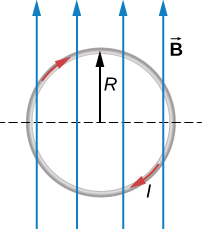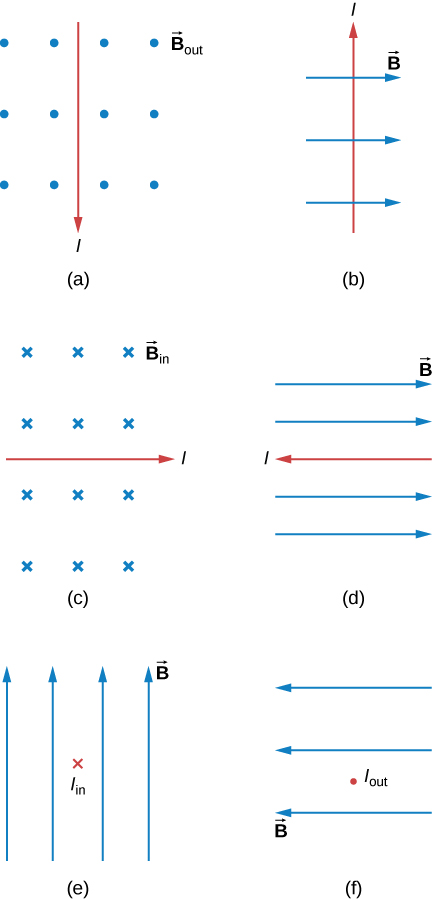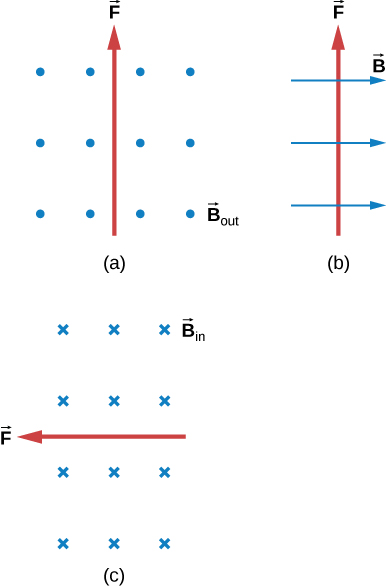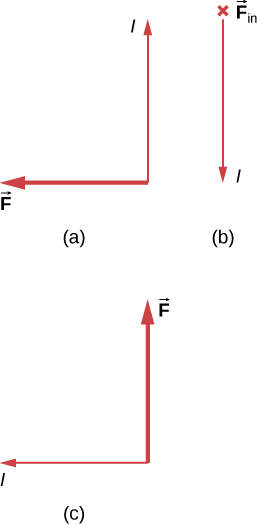| << Chapter < Page | Chapter >> Page > |
Check Your Understanding A straight, flexible length of copper wire is immersed in a magnetic field that is directed into the page. (a) If the wire’s current runs in the + x -direction, which way will the wire bend? (b) Which way will the wire bend if the current runs in the – x -direction?
a. bends upward; b. bends downward

where is the angle between the magnetic field direction (+ y ) and the segment of wire. A differential segment is located at the same radius, so using an arc-length formula, we have:
In order to find the force on a segment, we integrate over the upper half of the circle, from 0 to This results in:
The lower half of the loop is integrated from to zero, giving us:
The net force is the sum of these forces, which is zero.
Describe the error that results from accidently using your left rather than your right hand when determining the direction of a magnetic force.
Considering the magnetic force law, are the velocity and magnetic field always perpendicular? Are the force and velocity always perpendicular? What about the force and magnetic field?
Velocity and magnetic field can be set together in any direction. If there is a force, the velocity is perpendicular to it. The magnetic field is also perpendicular to the force if it exists.
Why can a nearby magnet distort a cathode ray tube television picture?
A magnetic field exerts a force on the moving electrons in a current carrying wire. What exerts the force on a wire?
A force on a wire is exerted by an external magnetic field created by a wire or another magnet.
There are regions where the magnetic field of earth is almost perpendicular to the surface of Earth. What difficulty does this cause in the use of a compass?
What is the direction of the magnetic force on the current in each of the six cases?

a. left; b. into the page; c. up; d. no force; e. right; f. down
What is the direction of a current that experiences the magnetic force shown in each of the three cases, assuming the current runs perpendicular to ?

What is the direction of the magnetic field that produces the magnetic force shown on the currents in each of the three cases, assuming is perpendicular to I ?

a. into the page; b. left; c. out of the page
(a) What is the force per meter on a lightning bolt at the equator that carries 20,000 A perpendicular to Earth’s field? (b) What is the direction of the force if the current is straight up and Earth’s field direction is due north, parallel to the ground?
(a) A dc power line for a light-rail system carries 1000 A at an angle of 30.0º to Earth’s field. What is the force on a 100-m section of this line? (b) Discuss practical concerns this presents, if any.
a. 2.50 N; b. This means that the light-rail power lines must be attached in order not to be moved by the force caused by Earth’s magnetic field.
A wire carrying a 30.0-A current passes between the poles of a strong magnet that is perpendicular to its field and experiences a 2.16-N force on the 4.00 cm of wire in the field. What is the average field strength?

Notification Switch
Would you like to follow the 'University physics volume 2' conversation and receive update notifications?